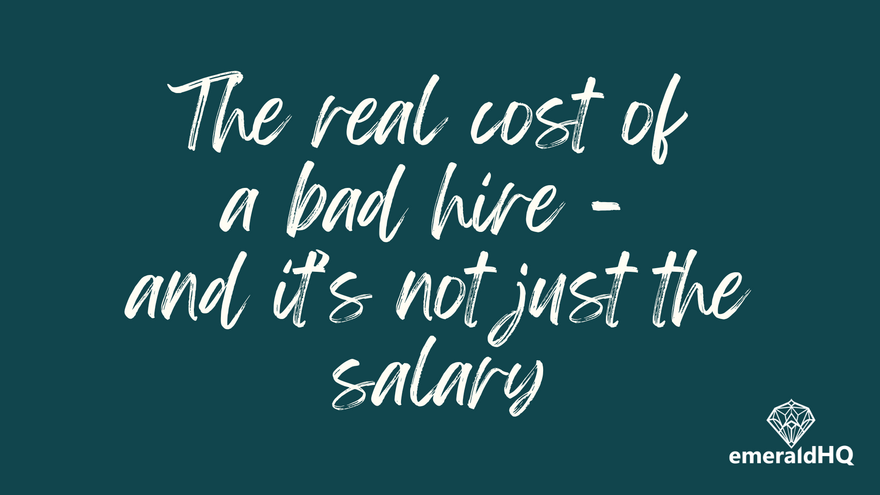
It’s easy to assume a bad hire only costs you their salary. Maybe a few thousand in wages and some time lost training. Frustrating, sure. But manageable, right?
Wrong.
The real cost of a bad hire goes far beyond the paycheck.
It shows up in your team’s morale, your leadership credibility, your client relationships, and your capacity to grow. And for small business owners, especially women trying to scale sustainably, the ripple effect can be massive.
This post isn’t here to scare you. It’s here to show you what’s really at stake - and more importantly, how to fix it before it happens.
Let’s break down what a bad hire actually costs, and why most leaders don’t even realise it’s happening until it’s too late.
Cost 1: Time lost on training, hand-holding and cleanup
You hire someone to save time. You imagine hours freed up from your calendar, tasks finally off your plate, space in your brain again. But when the hire isn’t the right fit, you don’t save time - you lose more.
You spend hours explaining things twice. Checking work. Picking up dropped balls. Repeating instructions. Rewriting content. Calling in favours to fix delivery errors.
And when it’s over? You spend even more time finding a replacement, rebuilding trust with your team or clients, and trying to untangle the mess.
A bad hire is not a neutral time swap. It’s a time sinkhole. And in small business, where every hour counts, that’s the first domino to fall.
Cost 2: Damaged team culture and internal trust
Even if your other team members don’t say it out loud, they notice when someone’s not pulling their weight. They notice when standards slip. They notice when you excuse bad behaviour or avoid hard conversations.
Here’s what happens when you keep a bad hire around too long:
✖️High performers feel undervalued and start to disengage
✖️Team members lose faith in your leadership decisions
✖️The “vibe” starts to shift from collaborative to cautious
Culture is a fragile thing. It doesn’t change in one day. It erodes over time, in tiny moments of looking the other way. And once it starts to crack, rebuilding it takes more energy than most leaders expect.
It’s not just about the person who’s not working out. It’s about the message it sends to everyone else: “This is the standard we accept here”. That message spreads fast.
Cost 3: Leadership credibility takes a hit
Your team looks to you to make strong, clear, confident decisions. When you bring someone on who clearly isn’t the right fit, and then avoid addressing it - your credibility takes a hit.
They start to wonder:
❔Why did she hire this person?
❔Does she really know what she’s doing?
❔What else is she ignoring or tolerating?
And if the hire creates conflict, misses deadlines, or fumbles in front of clients? Your reputation takes a hit too.
Leadership isn’t about getting every decision right. It’s about how quickly you notice, own and correct the wrong ones. If you delay, deflect or deny, your team stops trusting your judgment.
That’s not just a morale issue. It’s a delivery issue, a retention issue, and a brand issue - all rolled into one.
Cost 4: Client relationships and brand reputation
Clients feel the impact of a bad hire faster than you do. If someone on your team is slow to respond, vague in communication, inconsistent in delivery, or just not aligned with your values - your clients will clock it.
And they won’t always tell you.
They’ll start pulling back. They’ll delay signing the next contract. They’ll stop referring others. They’ll quietly look elsewhere.
You might never hear the real reason they drifted. But behind the scenes, one person’s underperformance just cost you a renewal, a case study, a glowing testimonial, and three word-of-mouth leads.
The smaller your team, the more every person carries your brand. A bad hire can unpick years of reputation-building in one messy project or awkward email.
Cost 5: Missed momentum and stalled growth
Every time you hire, you’re not just solving for today. You’re building for what’s next. You’re creating capacity, momentum and space to grow.
A bad hire doesn’t just slow you down. It steals the momentum you were about to use.
You put projects on pause. You delay launches. You step back into delivery instead of strategy. You stop pitching or showing up because you don’t have bandwidth.
And while you’re stuck patching leaks, the window of opportunity closes.
Momentum is one of the most powerful forces in business. But it’s fragile. It takes months to build and minutes to lose. The wrong hire doesn’t just mess with your calendar - it messes with your ability to grow.
So what’s the fix?
Hiring always carries some risk. But bad hires don’t happen out of nowhere. They happen when you haven’t defined the role, when your process is patchy, when leaders avoid hard calls, and when roles are filled out of panic instead of purpose.
Here’s how to reduce the risk of a bad hire and protect your business from the real costs:
✔️Start with clarity: What are the outcomes of this role? What does success look like in 30, 60 and 90 days?
✔️Hire with structure: Use a hiring rubric. Ask questions that test real behaviours. Involve someone else in the decision if you can.
✔️Onboard with intention: Map out the first week, first month, and first quarter. Don’t throw them in the deep end. Set them up to win.
✔️Manage performance early: Set a rhythm for check-ins and feedback - don’t make performance check ins a thing to fear, but a regular rhythm to actually maybe look forward to.. Don’t wait until things are falling apart.
✔️Trust your gut, then use process to confirm it: You can like someone and still assess them against objective standards.
Most importantly? Don’t wait too long to course-correct. Every week you delay a hard conversation is another week your business pays the price.
What if you’re in this situation now?
If you’re reading this and thinking, “I already made the bad hire,” take a breath. You’re not alone, and it’s not too late.
Start here:
✔️Review the original expectations you set. Were they clear, realistic and documented?
✔️Have an honest conversation. Be specific about where things aren’t working and what needs to shift.
✔️Set a short review period. Give them a chance to course-correct, but with a clear timeline and support.
✔️Protect your delivery. If needed, bring in extra support to stop the business bleeding while you resolve it.
✔️Reflect on what you’ll do differently next time. This isn’t just about the hire - it’s about the process that led to it.
A bad hire doesn’t make you a bad leader. Ignoring it does.
The women we work with aren’t trying to do business perfectly. They’re trying to do it better, smarter, more sustainably - and with values that hold up under pressure.
Hiring isn’t just a task. It’s leadership in action. And when you get it right, it unlocks everything else.
Ash + Emerald HQ 💎


Comments